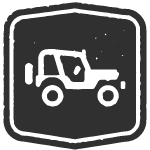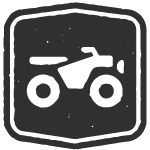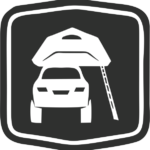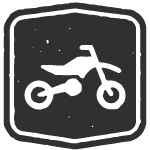
TRAVEL RESPONSIBLY
Travel responsibly on designated roads and obey posted signs, speed limits and traffic laws.
- Ride only on designated roads and obey all traffic laws, signals, and posted signs.
- Follow speed limits and adjust your speed based on traffic, weather, and road conditions.
- Stay in your lane and use proper passing techniques—never pass in no-passing zones or
around blind curves. - Maintain control of your vehicle at all times, avoiding sudden acceleration, braking, or erratic
movements. - Be mindful of road conditions, including potholes, gravel, slick surfaces, and debris that could
cause loss of traction. - Reduce noise in residential, natural, and quiet-use areas by avoiding excessive revving and
modifying exhaust systems responsibly. - Plan your route ahead of time to avoid restricted roads, unexpected closures, or high-traffic
congestion. - If traveling in a group, ride in a staggered formation to maintain visibility and space for safe
maneuvering. - Never mix operating a vehicle with alcohol or drugs
RESPECT THE RIGHTS OF OTHERS
Respect the rights of others, including pedestrians, cyclists and other drivers.
- Share the road with pedestrians, cyclists, and other motorists—always yield when necessary
and give ample space. - Be courteous by using your turn signals, honking only when necessary for safety, and avoiding aggressive behaviors.
- Maintain a safe following distance to allow time for braking and reaction.
- Avoid excessive noise in residential areas, near campgrounds, and in nature
preserves—revving engines unnecessarily can be disruptive. - Never trespass on private property or enter restricted areas.
- Be especially cautious around large vehicles, giving them space and avoiding their blind
spots. - Use extra caution near cyclists, ensuring at least three feet of clearance when passing.
- Be patient with slower-moving vehicles or pedestrians—everyone has the right to use the
road safely.
EDUCATE YOURSELF
Educate yourself prior to taking a trip by understanding licensing requirements, planning for your trip,
taking rider training courses and understanding how to operate your vehicle properly.
- Learn how to operate your vehicle safely, including braking, cornering, and emergency
maneuvers. - Obtain the proper license, registration, and insurance for your vehicle type.
- Always wear protective gear, including a DOT-approved helmet, gloves, eye protection,
sturdy footwear, and abrasion-resistant clothing. - Carry a well-stocked emergency kit with basic tools, a tire repair kit, first aid supplies, and a
charged phone or GPS device. - Familiarize yourself with local riding laws, including lane-splitting rules, helmet requirements,
and noise ordinances. - Understand the effects of weather on road traction—rain, ice, and wind can significantly
impact handling. - Check your motorcycle or three-wheeler before every ride—inspect tires, brakes, lights,
fluids, and controls to ensure everything is in working order. - Stay up to date with rider training courses and practice advanced riding skills to increase
safety.
AVOID SENSITIVE AREAS
Avoid sensitive areas and riding in areas that are environmentally fragile, restricted or dangerous
such as protected lands, wildlife habitats or areas with poor road conditions or closures.
- Stick to designated roadways and avoid cutting corners onto sidewalks, trails, or unapproved
areas. - Do not ride in protected lands, wildlife habitats, or closed roads that are restricted for safety
or environmental reasons. - Respect seasonal road closures and detours due to hazardous conditions or maintenance.
- Be cautious in areas with active wildlife—slow down and be prepared to stop if animals cross
the road. - Avoid excessive use of parking lots, roadside pull-offs, or undeveloped areas for stunts, high-
speed maneuvers, or racing. - Respect historic or scenic byways by minimizing disturbances and staying on paved roads to
prevent erosion. - If riding in rural or mountainous areas, be aware of unpaved roads that could become
impassable due to weather or terrain.
DO YOUR PART
Do your part by modeling appropriate behavior, leaving the area better than you found it, properly
containing fluids like oil and fuel and disposing of waste.
- Ride responsibly and set a positive example for other road users.
- Dispose of all waste properly—never litter or leave behind personal items.
- Avoid polluting waterways by keeping fluids like oil, gas, and coolant properly contained and disposed of.
- Participate in community road cleanup events or advocate for responsible riding policies.
- Maintain your vehicle to reduce environmental impact—properly inflated tires and a well-tuned engine improve efficiency and reduce emissions.
- Support businesses, organizations, and parks that promote responsible riding and conservation efforts.
- If you see unsafe or irresponsible riding behavior, lead by example and encourage proper road etiquette.
- Protect road access by respecting laws, avoiding reckless behavior, and promoting a positive image of motorcyclists and three-wheeled vehicle riders.
By following these principles, you contribute to safer roads, a better riding experience, and the long-term sustainability of our transportation system. Ride responsibly and enjoy the journey!















